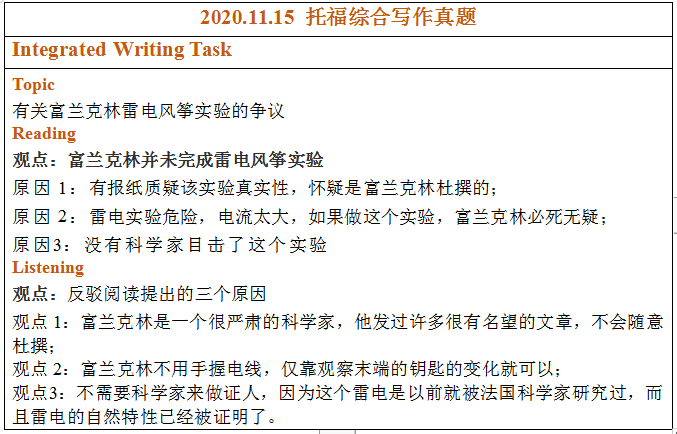
作者:北美考试院 托福写作组 王雨婷

本期考题与2018.9.16的综合写作考题内容重复。由此可见,历年考察过的真题被重复考察的可能性还是比较高的,考生平时备考时也可以以历年真题为材料进行备考练习。此次考察的话题属于托福综合写作考试中考频相对中等的历史类大话题的历史人物谜团的子话题。在TPO中有大量材料也涉及到了考古类相关话题,包括:TPO3, TPO8, TPO12,TPO28,TPO35。因此,TPO同样仍旧是考生备战综合写作,熟悉话题的重要资料。
Keywords: mystery, biography, character, controversy, doubt.
可以类比下列这些TPO的综合写作。
TPO28 Whether Peary had reached the North Pole
阅读部分:
总观点:Peary确实到达了North Pole。
• NGS调查了Peary的设备和记录确认了他确实到达了North Pole;
• 一个近期的探险队证实了Peary确实可以在37天内从Ellesmere到达North Pole;
• 有照片能证明他到达了North Pole。
听力反驳:
• 总论点:这些证据并不具有说服力
• NGS不客观,committee主要由Peary的好朋友组成,另外他们也只调查了三天;
• Tom Avery的探险和Peary并不完全相同,不能以此为依据;
• 照片不够清晰,其中的阴影已经很模糊,不能用来计算太远的位置来证明照片确实是在南极拍摄。
TPO3 A painting not being the work of Rembrandt
阅读部分:
总观点:An Elderly in A white Bonnet 不是Rembrandt的作品
• 妇女的衣着和帽子不匹配;
• 光和影不搭配;
• 画在一个粘在一起的木板上。
听力反驳:
总论点:确实是R的作品
• 画上的毛领是后加的,原来的衣领和帽子匹配;
• 去掉毛领后,光影相互搭配;
加毛领的时候增加了木板。

题目解析:
这次考题与TPO33的独立练习话题相近,讨论的是教育类合作学习和独立学习的话题。此题是一般对比类的问题,独立和合作的对比也是历年考试中非常常见的话题。本篇文章选择面对面的合作主要有2点理由,即:面对面交流的高效性和帮助的及时性。所以,本文采用四段论的结构,开头引入话题加观点陈述,两个主体段分别阐述原因并且举例进行论证,结尾段再次总结本人立场。
可参考如下范文:
More often than not, students will encounter the situation where they must work collaboratively with the others to implement a project in scholastic occasion. However, whether to work face to face or to work independently is largely to up to the students themselves. As far as I am concerned, gathering together and accomplishing the project face to face is a better choice.
First, in-person interaction can have a catalytic effect on the progression of the project. Even if the task can be divided into three parts, the necessity of discussing with each other still exist. At least, they need to inform each other about the progression, which helps to avoid “free-ride” situation or overlap in works. This is where face to face communication matters as it provides a great opportunity for students to directly inform each other their personal opinion, omitting the need to waiting for the others’ response over the internet or text message. Ultimately, the acceleration of idea changes contributes to the general accomplishment of the project. Imagine that a student is required to finish a group presentation regarding the knowledge points he has just learned in physics together with the other two students. Although they can split the knowledge points into three separate parts, each one responsible for one aspect, the discussion about how to optimize their PPT or how to organize the sequence the their three parts is still significant. If they choose to work independently, without any discussion, the overall outcome of the presentation may be much undesirable; Even if they have few interaction over the internet or phones, they may find much time is spent on waiting for the response from the other.
Second, working together also provides an atmosphere in which students offer instant assistance to each other. Hardly can a student be so knowledgeable and intelligent that he can finish a project all by himself. Team members, with dissimilar expertise and knowledge accumulation, can contribute to the project from different fields when working together. What is worth mentioning is that the assistance is more timely when they gather together. For example, last month, the teacher asked us to make a review regarding history of the Election of American President. I was not familiar with the relevant knowledge, while my teammate, Mike, was especially fascinated by the American Politics. His comprehensive and passionate explanation about the topic gave me help in finishing my part of the project. Had I not worked with him face to face, I would have had to looked those information up over the Internet, which is quite time-consuming.
As has been presented above, working face to face is a better choice when it comes to group work.